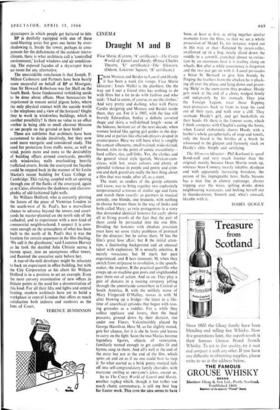CINEMA
Draught M and B
Theatre, certificate.)—The Silencers. (Odeon, Leicester Square, 'A' certificate.) El ROM Moreau and Bardot to Laurel and Hardy 1-1 it has been a week for romps. Viva Maria (director : Louis Malle) is the plushiest. On the way out I met a friend who has nothing to do with films but a lot to do with fashion and who said: 'I had to come, of course, to see the clothes.' And very pretty and dashing, what with Pierre Cardin designing and Moreau and Bardot inside them, they are. For it is 1907, with the line still bravely Edwardian, bodies a definite corseted shape and skirts a well-defined length—none of the hideous, hesitant air of the next decade, when women looked like ageing girl guides in the day- time and at parties like charade-players draped in counterpanes. Here we still have what is roughly the cancan silhouette, small-waisted, wide-skirted, booted, trim to the point of comic masculinity— hard collars, ties, cuff-links. Yes, the clothes and the general visual style (garish, Mexican-cum- circus, with hot, sweet colours and plenty of splendid violence in purple and peony and crim- son and dark green) are really the best thing about a film that was made, after all, as a stunt.
The stunt, as readers of the gossip columns will know, was to bring together two explosively temperamental actresses of similar age and fame and match them exactly: as partners in musical comedy, one blonde, one brunette, with nothing to choose between them in the way of looks and both called Mary; as twin protagonists in a story that demanded identical honours for each; above all as living proofs of the fact that the pair of them could be persuaded into the one film. Dividing the honours with absolute precision must have set some tricky problems of protocol for the director; but he solves them. M has the film's great love affair, but B the initial atten- tion, a fascinating background and an unusual talent with explosives; M is sexually selective, B merely voracious; but M starts her part experienced, and B hers innocent; M, when they switch from striptease to revolution, is the speech- maker, the inspirer, B the practical guerrilla who creeps up on machine-gun posts and singlehanded puts them out of action. And so on. They play a pair of dancers in a touring company jolting through the countryside somewhere in Central or South America. B, with the unlikely name of Mary Fitzgerald O'Malley, moves in with M after blowing up a bridge—the latest in a life- time of anarchical episodes that began with toss- ing grenades as a toddler. For a while they collect applause and lovers, then the local peasants, ground down by their dictator, rise under one Flores, Valentinoishly played by George Hamilton. Here M, so far slightly muted, gets her chance, for it is she he loves and leaves to carry on the fight. Soon the two Marias become legendary figures, objects of veneration, familiarly named enough to get candles lit and hymns sung to them. And all's well at the end of the story but not at the end of the film, which spins on and on as if no one could bear to stop it. So what started as a brisk pretty musical tails off into self-congratulatory family charades, with everyone smiling at everyone's jokes, except us.
So to The Crazy World of Laurel and Hardy, another ragbag which, though it has rather too much chatty commentary, is still my best buy for Easter week. This time the idea seems to have been, at least at first, to string together similar moments from the films, so that we see a whole procession of Model Ts, for instance, wiped out in this way or that—flattened by steam-roller, swallowed up in a bog, neatly sliced down the middle in a sawmill, crunched almost to extinc- tion by an enormous boat it is trailing along on wheels. But after a while consistency is forgotten and the two just get on with it. Laurel persuades a fierce St. Bernard to give him brandy by flinging the feathers from the chicken he is pluck- ing all over the place, and lying down and groan- ing 'Help' in the snowstorm they produce. Hardy gets stuck at the end of a chute, wedged firmly and indignantly by his stomach. They join the Foreign Legion, wear those flapping neck-protectors back to front to keep the sand out of their eyes, and walk over a cliff. They serenade Hardy's girl, and get bucketfuls on their heads. Or there is the famous scene, which I think competes with Chaplin's eating the boots, when Laurel elaborately shaves Hardy with a barber's whole paraphernalia of soap and towels, only the beard is the bristles of a brush he whammed in the gluepot and furiously stuck on Hardy's chin. Simple and satisfying.
The Silencers (director : Phil Karlson) is spoof Bond-stuff and very much funnier than the original, mainly because Dean Martin sends up, whereas Sean Connery merely inhabits, deadpan and with apparently increasing boredom, the person of his impregnable hero. Stella Stevens has a nice line in clumsy espionage, always tripping over the wires, spilling drinks down neighbouring waistcoats, and locking herself out in thunderstorms. Smooth and, what's unusual, likeable with it.
ISABEL QUIGLY


































 Previous page
Previous page